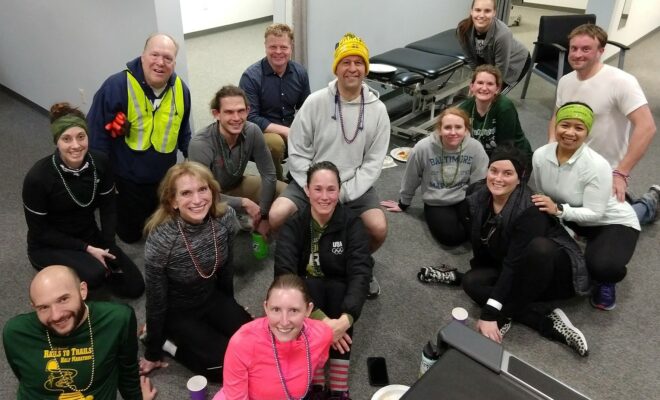Great People at Any Pace

Great People at Any Pace
By Jeanna Trzebiatowski
Editor’s Note: What follows personifies the wide net of Greg Marr’s silent sports vision. Jeanna Trzebiatowski’s story connects the experienced runner with those who wish to run, if only … A story to not only read, but also to share, to begin the dialogue about fears and perhaps embarrassments, and what running and running communities truly offer. Thank you, Jeanna!
The Excuses
“No one will take me seriously.” “I’m going to slow everyone down.” “I don’t look like a runner.” “I’m not going to fit in.”
These thoughts pass through the head of so many people struggling with, and then dismissing, the idea of running even though there’s no such thing as a runner’s body or normal pace. The truth? A blessing hidden by fear, but it’s what I’ve learned: No one cared what I looked like, or my pace.
From ER to Welcoming Arms of Runners: In 2016, I experienced a panic attack that put me in the emergency room. I had no history of panic or anxiety attacks before, and it came on while my now-husband and I were watching a movie at home, and it broke me. Over the following months, I felt what other sufferers feel: constantly panicked about whether or not I was going to have another panic attack. The counselor I found told me to try physical activity, specifically running or walking.
With mental-illness genes in my family, mixed with my stubbornness against taking unnecessary medications, I felt running was my only option. The first intentional mile I ever tried to run was about three weeks after I quit smoking. I hopped on a treadmill, started to run, and, battling hard against fatigue, I slowed until I was at a walking crawl. I gave up. Only seventeen minutes in, and I hadn’t finished the mile. I went home feeling like a failure. Looking back, I understand how easy it was to feel hurt. However, I didn’t know then what I know now.
Following a Pinterest program, I started a “21-Day Running for Weight Loss.” Terrible, yet I finished. Then, I started working through my first Couch-to-5K program, and things got easier. I was slow but moving, and feeling good about what I was accomplishing.
Over the next month, I was sleeping better. If my mind started to drift, and I hadn’t run yet, I put on my running shoes. During this period, I ran alone. I had started running for my mental stability, but running alone was the main reason I didn’t like it as much as I do now.
Four years later, I am a member of many Facebook running groups, and have started my own Run Club that meets every week. We welcome all runners and walkers, and laugh every time we get together. Getting out there, no matter how fast or how far. Gathering together afterwards. Accepted exactly as I am.
Message to the Slow Runner
Usain Bolt will always sprint faster than you. Yet, as long as you’re moving forward, you’re lapping your former self on the couch, and every non-runner. The great runner and writer Hal Higdon made clear in his best-selling book, Marathon: The Ultimate Training Guide, “There is no such thing as an average runner. We are all above average.”
Need more proof?
According to USA Today, fewer than one percent of the US population will complete a half marathon or greater in their lifetime. Whether running or walking, that one percent is going the distance. No speed or body type identified, just the one percent who moved that far. Also, according to Running USA, just under 9 million people in the US registered for a 5K. Seems like a big number. However, when compared to nearly 330 million Americans as of 2018, that’s still less than three percent. If all it takes is 3.1 miles to become part of the top three percent in America, why not start now?
Message from the Runner
Weight loss, self-confidence, heart and mental health, social groups, the reasons to run go on. It’s a social experience, mental health session, and workout all wrapped up into one easily accessed activity.
Something I’ve learn at work and in leadership classes is “Finding your why.” Your why defines your purpose for doing something. It reflects in everything you work hard at. Running is one of these things. If you try to run only to see what it’s like, or because someone else is doing it, that’s not a bad thing. But you’re probably not going to continue.

Jeanna Trzebiatowski completes her first-ever half marathon, the Mt. Charleston Half, in Las Vegas, April 2019. Photo by her husband, Tommy.
Many run to lose weight. This “why” can be deeper than a number on a scale. It can mean increased self-confidence and a sense of increased body strength. Also, higher levels of happiness and satisfaction.
My therapist told me, “Exercise is the most underutilized antidepressant.” Fresh air and physical activity are the best medicines for everyone, especially those with anxiety and depression. Scott Douglas says in his book, Running Is My Therapy, “If you’re depressed, you might be more likely to show up for someone else than you are to show up for yourself.”
This is where running groups become important. Whether it’s a Facebook group you turn to for advice, or a weekly meetup you look forward to, these groups can keep you going. Making meaningful connections through these groups gives you purpose. Members hold each other accountable, and, like Douglas said, you may show up when you’re invited even when your self-motivation feels low.
Getting to the Group
The running community can seem competitive. But show up to a running group for the first time and you’ll experience an unmatched level of support. With my running community, I had never before experienced so much encouragement. People wait for me to finish a race, and then I wait for people behind me to finish. That’s what the running world is — a giant cheering section for one and all.
Whatever your excuse, if you don’t show up, others will continue to run. Others will feel the encouragement and feel great. Please look beyond your fears. Don’t be left out. Let the running community raise your spirits.
The Slow Runners Community and the Not-So-Fast 5K
Still nervous? A great place to start is online. Facebook lists running groups of all levels to join. One of the most unique is the Slow Runners Community, with over 21,000 members and counting. You’re far from alone!
Check it out at: facebook.com/groups/slowrunnerscommunity.
Joining gives you access to a full spectrum of runners, stories, questions, and answers. The pace times of this online community are reassuring, anywhere from a twenty-two-minute mile, to a six-minute mile. This amazing running group proves that pace is only a state of mind.
Two local running clubs in my area combined to do a Not-So-Fast-Tuesday 5k (and what a great name for a race is that!) with a potluck at the end. Even with my small-town area, many people showed up and had an awesome time. Some, like me, ran slower than the majority of the members. However, that didn’t change the fact that we all ran the same distance, and enjoyed the same company, food, and drinks at the finish.
What We Teach Each Other
I used to think I was too short, heavy, and slow to be taken seriously as a runner, or to enjoy a running group. So, I looked for reassurance from others, and it never hurts to do your own research.
“Being a slow runner made me self-conscious,” said Kristina Wons, but now she’s a member of SPARC, a local running club in Wisconsin. Amanda Barish added, “If you say, ‘I ran 5 miles today,’ no one’s going to ask, ‘How long did it take you?’”
Amanda’s blog, Running for Pasta, which I highly recommend, is an inspiring story about overcoming self-labeled stereotypes and becoming a runner.
Check it out at: facebook.com/runningforpasta
For the accomplished runners, if you know a loved one or friend who won’t run or try other silent sports because of their self-doubts and assumptions, please show them my story. They are the reasons why I have shared it. Let them know what people in runners groups already know—that the running community does not care about size, shape, or pace. All we want is for you to show up.
The camaraderie will take care of everything else.
* * *
Please scroll (all the way!) down to post your comments.
Thank you!


